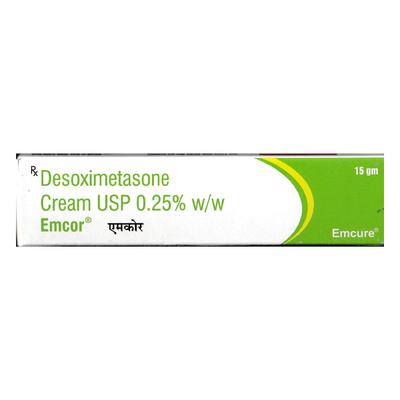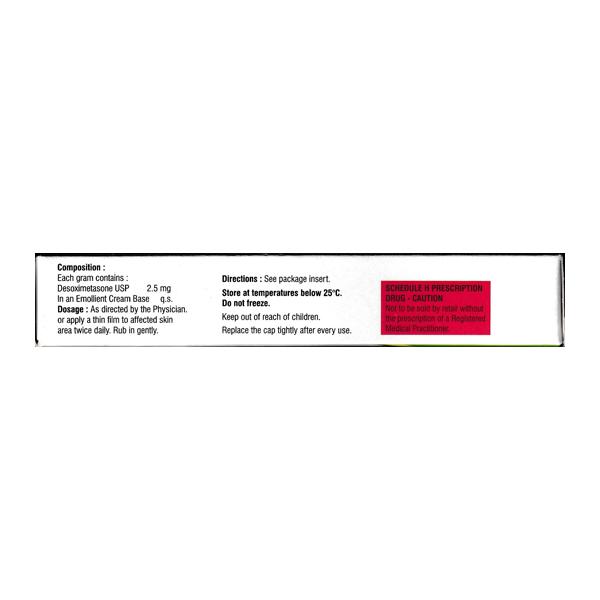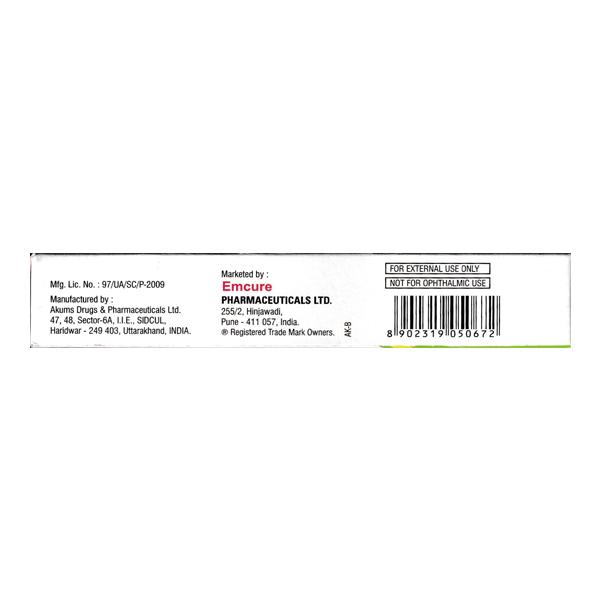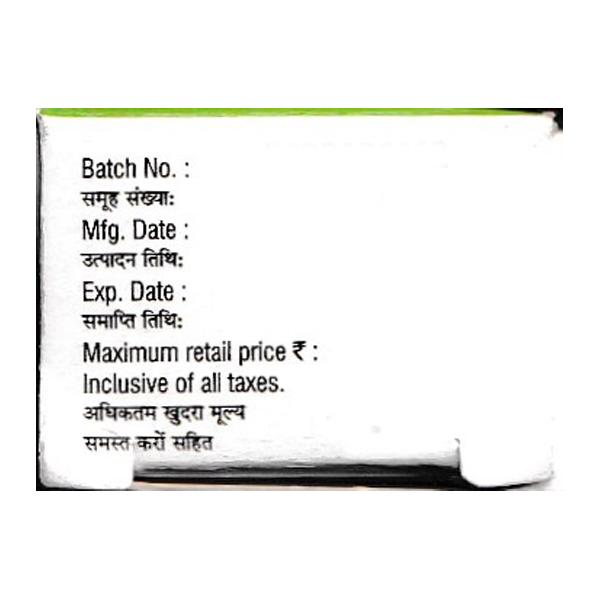

Netmeds First Membership
Quick Links
Introduction About EMCOR 0.25% CREAM
EMCOR 0.25% CREAM contains Desoximetasone which belongs to a group of medicines called Topical corticosteroids. EMCOR 0.25% CREAM is used to provide relief from the inflammatory and pruritic manifestations of corticosteroid-responsive dermatoses, which is a skin condition that occurs when managed with corticosteroid medications in affected individuals.
EMCOR 0.25% CREAM is not recommended for use in patients allergic to Desoximetasone.
Before applying EMCOR 0.25% CREAM, inform your doctor if you suffer from any other skin infections.
EMCOR 0.25% CREAM should be used with caution in pregnant and breastfeeding women only if necessary.
EMCOR 0.25% CREAM should be used with caution in children and adolescents (aged below 18 years) since it may cause side effects such as HPA axis suppression (condition of poor body defense against infection), Cushing’s syndrome (hormonal disorder) and intracranial hypertension (high blood pressure in brain) in child. The medicine is advised to be used with caution in elderly patients (aged 71-years and above) after consulting the doctor.
The most common side effects of applying EMCOR 0.25% CREAM are burning sensation, itching, irritation, dryness, folliculitis (condition marked by inflammation of hair follicles), hypertrichosis (condition marked by excessive hair growth), and/or allergic contact dermatitis (red, itchy rash). Consult your doctor if any of these symptoms worsen.
Uses Of EMCOR 0.25% CREAM
- Provides relief from the inflammatory and pruritic manifestations of corticosteroid-responsive dermatoses in affected individuals
How EMCOR 0.25% CREAM Works
EMCOR 0.25% CREAM works by the induction of lipocortins (inflammatory enzyme) that results in the decreased biosynthesis of prostaglandins and leukotrienes (potent mediators of inflammation) which manages the release of arachidonic acid (hormone responsible for inflammatory process in the skin) thus providing relief from inflammatory and pruritic manifestations of corticosteroid-responsive dermatoses in affected individuals.
How to use EMCOR 0.25% CREAM
Apply EMCOR 0.25% CREAM as directed by your doctor. It is for external use only. Wash your hands before and after use to ensure hygiene is maintained. Avoid contact of this medicine in your eyes. Your doctor will decide the correct dose and duration for you depending upon your age, body weight, and disease condition.
Side Effects Of EMCOR 0.25% CREAM
Common
- burning sensation, itching, irritation, dryness
- folliculitis (condition marked by inflammation of hair follicles)
- hypertrichosis (condition marked by excessive hair growth)
- acneiform eruptions (skin disorder marked by papules and pustules)
- hypopigmentation (skin disorder marked by loss of skin color)
- perioral dermatitis (red rash that circles the mouth)
- allergic contact dermatitis (red,itchy rash)
- maceration of the skin (broken skin)
- secondary infection such as boils, toe web infection
- skin atrophy (skin disease marked by loss of elasticity of skin)
- striae (stretch marks)
- miliaria (heat rash)
Uncommon
- folliculo-pustular lesion (recurrent skin disorder of unknown cause)
Rare
Stop applying EMCOR 0.25% CREAM and contact your doctor if you experience any of the following side effects:
- irritation (in children)
How To Manage Side Effects
Dry Skin:
Try moisturizing your skin with an ointment, cream, lotion two or three times a day, or as often as needed. Moisturizers help to keep the area moisture, so they work best on damp skin. After you bathe, pat your skin dry then apply your moisturizer. Try to avoid using skin care products and soaps that contain alcohol, fragrances, dyes, or other chemicals.
Warning & Precautions
Pregnancy
EMCOR 0.25% CREAM should be used during pregnancy only if it is clearly necessary. Consult your doctor before applying the medicine.
Breastfeeding
EMCOR 0.25% CREAM should be used with caution in breastfeeding women. Consult your doctor before applying the medicine.
Allergy
Do not apply EMCOR 0.25% CREAM if you are allergic to Desoximetasone, and/or any other ingredients of this medicine.
Others
Before applying EMCOR 0.25% CREAM, inform your doctor if you:
- suffer from any other skin infections
Use in Pediatrics:
EMCOR 0.25% CREAM should be used with caution in children and adolescents (aged below18 years) who may develop side effects such as HPA axis suppression (condition of poor body defense against infection), Cushing’s syndrome (hormonal disorder) and intracranial hypertension (high blood pressure in brain) upon receiving the medication. It is advised not to use tight-fitting diapers or plastic pants while applying the medicine to the child. Consult your doctor before applying the medicine to the child.
Use in Geriatrics:
EMCOR 0.25% CREAM is used with caution in elderly patients (aged 71 years and above). Consult your doctor before applying EMCOR 0.25% CREAM.
Interactions
A. Drug-Drug Interactions:
Tell your doctor about all the medicines you take, including prescription, non-prescription medicines and herbal supplements.
Overdosage:
If you or anyone else accidentally applies too much EMCOR 0.25% CREAM, consult your doctor immediately or visit the nearby hospital. Symptoms of overdose are corticosteroid-related dermatitis (a skin disorder that occurs due to prolonged use of corticosteroid), HPA axis suppression (a condition that causes poor body defense against infection), Cushing's syndrome (hormonal disorder), hyperglycemia (high blood sugar), and/or glucosuria (low sugar in urine).
Synopsis
| Drug | : | Desoximetasone |
| Pharmacological Category | : | Topical corticosteroid |
| Therapeutic Indication | : | Corticosteroid-responsive dermatoses |
| Dosage Forms | : | Cream |
FAQs About EMCOR 0.25% CREAM
Q. What EMCOR 0.25% CREAM is used for?
A. EMCOR 0.25% CREAM is used to provide relief from the inflammatory and pruritic manifestations of corticosteroid-responsive dermatoses, which is a skin condition that occurs when managed with corticosteroid medications in affected individuals.
Q. How is EMCOR 0.25% CREAM applied?
A. Apply EMCOR 0.25% CREAM as directed by your doctor. It is for external use only. Wash your hands before and after use to ensure hygiene is maintained. Avoid contact of this medicine in your eyes. Your doctor will decide the correct dose and duration for you depending upon your age, body weight, and disease condition.
Q. What are the side effects of EMCOR 0.25% CREAM?
A. The most common side effects of applying EMCOR 0.25% CREAM are burning sensation, itching, irritation, dryness, folliculitis (condition marked by inflammation of hair follicles), hypertrichosis (condition marked by excessive hair growth), and/or allergic contact dermatitis (red, itchy rash). Consult your doctor if any of these symptoms worsen.
Q. Can EMCOR 0.25% CREAM be applied by pregnant or breastfeeding women?
A. Yes, EMCOR 0.25% CREAM can be applied but with caution during pregnancy and in breastfeeding women only if necessary. Consult your doctor before applying the medicine.
Q.Can EMCOR 0.25% CREAM be used in children?
A. Yes, EMCOR 0.25% CREAM can be used but with caution in children and adolescents (aged below 18 years) since the medicine may cause side effects such as HPA axis suppression (condition of poor body defense against infection), Cushing’s syndrome (hormonal disorder) and intracranial hypertension (high blood pressure in brain) in child. Consult your doctor before applying the medicine.
References
1. KD. Tripathi. Histamine and Antihistaminics. Seventh edition. 2013. Page – 167.
2. Sarah Gabros, Trevor A. Nessel; Patrick M. Zito. Topical Corticosteroids. NIH National Library of Medicine, National center for biotechnology information. November 2021 [Accessed on 30th May 2022] https://www.ncbi.nlm.nih.gov/books/NBK532940/
3. Hobart W Walling and Brian L Swick. Update on the management of chronic eczema: new approaches and emerging treatment options. NIH National Library of Medicine, National center for biotechnology information. PMC PubMed Central. July 2010 [Accessed on 30th May 2022] https://www.ncbi.nlm.nih.gov/pmc/articles/PMC3047944/
4. Padagis Israel Pharmaceuticals Ltd . Desoximetasone cream. DailyMed; National Library of Medicine; National Institute of Health. August 2021[Accessed on 30th May 2022] https://dailymed.nlm.nih.gov/dailymed/lookup.cfm?setid=4ad6c159-4daa-4a33-8db6-351b5263323d#i4i_precautions_id_prec
5. Taro Pharmaceuticals Inc. Desoximetasone. U.S. Food and Drug Administration. April 2011[Accessed on 30th May 2022] https://www.accessdata.fda.gov/drugsatfda_docs/label/2012/074904Orig1s015Lbl.pdf
Useful Diagnostic Tests
- Percutaneous skin test
- Allergen-specific immunoglobulin E (IgE) antibody test












